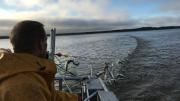After college, Jim Merriner ’93 returned home to Alaska and worked as a paralegal and private investigator for a year. But before and during college, he’d volunteered when he could at a summer camp and coached wrestling, so he knew he “loved working with youth, and since summers were already occupied with commercial fishing, it made sense to look into education for a career.”
He earned a teaching certificate from the University of Alaska in 1995 and an M.Phil. in school development/school leadership from the University of Cambridge in 1996. Back home again, he moved, after several years of teaching social studies in junior high and high school, into administrative roles in both private and public schools. When incoming lieutenant governor Sean Parnell called “out of the blue” in 2006, asking him to become his chief of staff, Merriner accepted, “to build relationships with Alaska's political players and learn first-hand how things get done in Juneau.” Those experiences, including appointment to the state’s board of education in 2010, taught him the nuances of how to advocate effectively for school districts within state government, and Harvard, he says, had equipped him with “the problem-solving and communication skills to lead an educational organization.” In 2016, he felt ready to accept a new role as assistant superintendent of the Galena City School District, in west-central Alaska. He’s now superintendent.
“Living in an isolated off-the-road-system community is not a piece of cake,” he acknowledges, but as lifelong Alaskans, Merriner and his family welcomed the opportunity to move to remote Galena. With only 500 year-round residents, the city nevertheless has a major educational footprint across the state. Besides its pre-K-12 school, serving about 100 local pupils, the school district runs Galena Interior Learning Academy (GILA), a boarding school for 230 high-school students. Housed in a former Air Force station, GILA has facilities rare for rural Alaska—a swimming pool, gym, racquetball courts—and an innovative program of college-prep courses, industry certifications, and vocational training in aviation, applied mechanics, construction trades, cosmetology, health science, and information technology.
Merriner also administers IDEA (Interior Distance Education of Alaska), a home-schooling-support effort that serves 4,200 Alaska students and is technically the largest school in Alaska. A smaller program within IDEA, iGrad, aids 330 recent high-school drop-outs. Its students often lack adult support, he explains: “They are on their own, having fallen through the cracks. When they contact us, they are at a point when they want to be responsible for their own education. Some are homeless, but we set them up with Internet access, a laptop, and online courses. We’ve heard of at least one student living in/working out of his car. We have teachers who work with them via phone, email, or Skype. If we haven’t heard from them in a week, we call them.”
His biggest challenge, he says, is lack of adequate financial resources. State funding for K-12 education has lagged inflation for years: he estimates that in terms of per-pupil state funding, the school district received approximately $2.5 million less in 2018 than it did in 2011. Merriner has scheduled meetings with state legislators to explain how tenuous the continuation of GILA is as a result.
Long work days include strategic-planning meetings, occasional travel for district business, eating lunch with students when possible, and attending after-school student activities. He is particularly proud that GILA’s entering students, who are often five grade-levels below where they should be in reading, regularly gain “well over a grade-level increase, sometimes even two grade levels” yearly. These mostly Alaska Native and economically disadvantaged students, he says, “sacrificially leave their homes to live with us to access knowledge and skills not available in their remote villages.”
Graduations remind him why he remains in education. “Some of our iGrad students have distant relatives who show up, but if they don’t, they bring up a teacher or administrator and they put their arms around them and tell their story. There are a lot of tears.” Students “can sense whether you care about them from the get-go,” he says. “If you don’t exude care and concern and love for kids, you won’t be successful educating them.”










